Particle Size Reduction For Animal Feeds: Part 2
Grinding Equipment
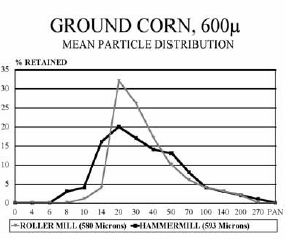
Both roller mills and hammermills have been applied to the task of particle size reduction or grinding in feed milling applications. Hammermills have traditionally been used to produce the finer grinds commonly used for pelleting, and for many mash (meal or non pelleted) feed applications as well. The hammermill is a relatively simple machine and requires a fairly low degree of skill in regards to both the operation and maintenance.
However, recent significant changes in the industry have caused many to reassess their approach to particle size reduction. Increasing energy costs, increasing customer awareness of feed quality, and environmental concerns all challenge the validity of the hammermill as the only alternative for particle size reduction (grinding) applications. In the following discussions, both roller mills and hammermills will discussed in terms of equipment selection, operating conditions and parameters, and relative costs to acquire and to operate.
Roller Mill Grinding
In recent years, more attention has been given to the roller mill set up to function as a grinder. Several important factors have contributed to this including energy costs, product quality concerns, and environmental issues. Each of these will be reviewed in turn below.
Energy costs have escalated dramatically in the last 20 years, and at the same time margins in feed manufacturing have decreased. As a result, cost savings of $0.10 to $0.40 per ton for grinding can mean a significant difference in the bottom line of a feed manufacturing operation. Because of an efficient reduction action, roller mill grinders will produce 15 to 40% more tons/hour at a given horsepower than traditional "full circle" hammermills when producing the same finished particle size. Roller mill energy savings advantages will be even greater when compared to older half screen hammermills with direct connected fans. In many instances the energy savings potential of a roller mill grinder will justify the capital expenditure.
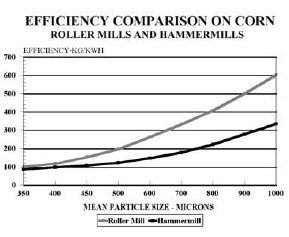
Product quality concerns have always been a part of feed manufacturing, and there are many quantitative methods for measuring feed quality. Nonetheless, the physical traits (appearance, feel, handling characteristics) will always influence the feed buying customer. Because the grind produced by a roller mill is very uniform, the finished product(s) have an excellent physical appearance. The low level of fines and lack of oversize particles make a feedstuff with excellent flow and mixing characteristics. This is especially important for mash or meal type feeds where the flow from bins and feeders can be difficult to regulate, and where segregation and separation may occur in shipping and handling. Because the product is not heated significantly in the grinding process, less moisture is driven off and the finished product is not prone to hanging up in bins, spoiling in storage, and other maladies related to heat and moisture.
Environmental issues of concern to the feed manufacturer today include particulate emission, employee exposure to noise, and the risk of fire and explosion. Because roller mill grinders create fewer fines, less material is likely to be lost to the atmosphere. Additionally, high efficiency hammermill installations require air assist to achieve the rated performance. Cyclones and bag filters are not 100% effective in removing the particulates from the air streams and so some emissions will occur. Whether or not these emissions are a problem will depend on widely varying local conditions and regulations. Because roller mill grinders operate at lower speeds and with a different kind of reduction action, less noise is generated in the grinding process. In many cases this reduction in noise means a roller mill grinder will not require a separate enclosure to limit employee exposure to high noise levels. Lower operating speeds in roller mill grinders mean less frictional heating and less inertial energy (such as thrown hammers) in a hammermill. This reduction in ignition sources combined with less dust in the product stream greatly reduces the risk of fire in the grinding operation.
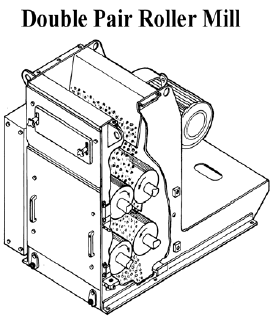
The Roller Mill Grinder
Not every make or style of roller mill can be applied to the task of grinding. Essentially, a roller mill grinder will utilize rolls from 9 to 12 inches in diameter operating at differential speeds. Roll speeds will be higher for roller mill grinders than for cracking/crimping and flaking mills. Typical peripheral speeds range from 1,500 feet/minute to more than 3,000 feet/minute for 12" diameter rolls. Due to higher speeds and greater loads, the bearings and shafts of a roller mill grinder experience far more demanding conditions than cracking or crimping mills.
Differential ratios vary from about 1.2:1 up to 2:1 for typical feed milling operations. Lower differential ratios do not permit adequate reduction, while higher ratios can lead to excessive roll wear. It is essential that the roll speed differential be maintained when operating at full motor loads in order to achieve the desired grinding results. Inter roll drives may utilize spur gears, roller chains and sprockets, double sided V belts, toothed belts (timing belts), or shaft mounted gear reducers to achieve this differential action. Each type of drive has its merits and limitations. Generally speaking, the simplest drive that is suitable for the maximum horsepower applied will be the best.
Because the roll clearances need to be maintained under demanding conditions, the mill housing and roll adjustment mechanism of the roller mill grinder must be more robust than for cracking and crimping mills. More precise roll position adjustments must be made, and better control over the feeding is necessary in order to achieve the full benefits of the roller mill grinder through its range of capabilities. Rolls must be operated in parallel and in tram to reliably produce quality finished products. For these reasons, many of the existing cracking and crimping mills cannot be made to function effectively as a roller mill grinder. The figures below depict roll conditions of parallel and tram.
A roll type feeder is generally preferred for a roller mill grinder to insure a uniform feed across the full length of the rolls. While other types of feeders can work, including simple slide gates or more complex vibratory feeders, the roll type feeder covers a wide range of applications very efficiently. Because roller mill grinders do more work and use more horsepower than cracking and crimping mills, roll wear rates will be greater. Rolls will require recorrugation when the capacity of the mill drops by 20- 30% or when finished product quality is not longer acceptable. Because they do not effectively reduce fibrous materials, roller mill grinders are best applied to grinding friable products such as corn, wheat, milo, soybean meal, and similar products. Roller mill grinders are also commonly applied to feed additive materials and fertilizers where free flowing, granular end products are desired, and when it is desirable to minimize fines.
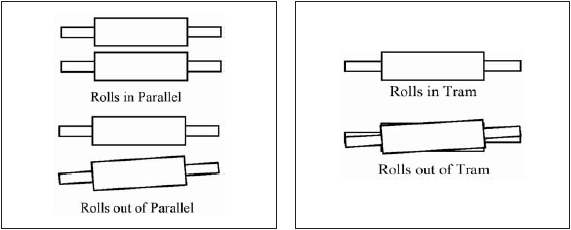
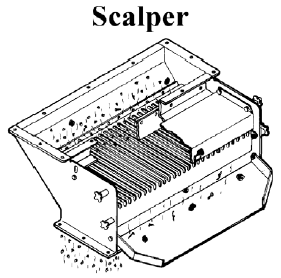
Cleaning grain ahead of a roller mill can improve the roll life and the quality of the finished product(s). Normally all that is required is some form of scalper to remove gross oversize pieces; stalks, cobs, clods, stones, and the like. Magnetic protection ahead of the mill will insure a minimum amount of tramp metal enters the rolls. While grain for a roller mill grinder does not require any more cleaning than grain going to a hammermill, some objectionable fibrous materials may be passed unprocessed through a roller mill grinder. Rolls tend to be self-limiting in so far as the size of materials that will be pulled into the nip. Rolls cannot get a purchase on large stones, etc. and though roll wear may be accelerated by the presence of such objects, the mill is not likely to suffer acute failures.
The primary claims against roller mill grinders are high initial cost, maintenance hours to change rolls, and the need to carry spare rolls in stock. Roller mills are generally more expensive than hammermills of equal capacity, but total installed costs for the two systems are not so different when all factors are considered. Items such as larger motors, starters, and wiring, air assist systems including fans and cyclones, and additional labor to install the more complex material handling systems of hammermills tend to offset the differences in the basic equipment costs. Because roller mill maintenance (roll change) occurs in a concentrated block the actual time required appears to be significant. In fact, when compared on a "maintenance hours per ton" basis, roller mill grinders are quite competitive with hammermill grinders. Finally, spare rolls may amount to a fair capital investment, but again comparing the actual cost on a "per ton" basis, the maintenance costs of recorrugation and roll replacement are within $0.01 to $0.03 per ton of hammermill maintenance costs.
Particle Size Reduction For Animal Feeds: Part 3 - Hammermill Processing, Equipment Description, Basic Machine Characteristics
Particle Size Reduction For Animal Feeds: Part 4 - Basic Operational Concepts, Tip Speed, Hammers
Particle Size Reduction For Animal Feeds: Part 5 - Screens, Feeders, Air Assist
Particle Size Reduction For Animal Feeds: Part 6 - Other Considerations




